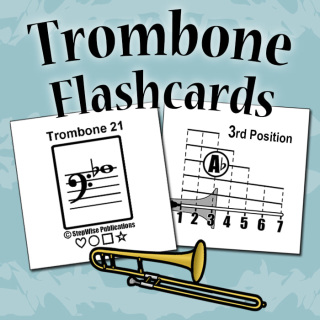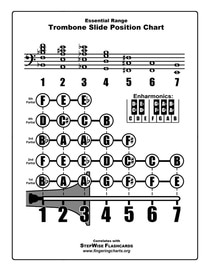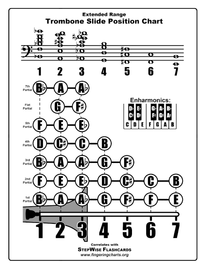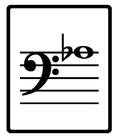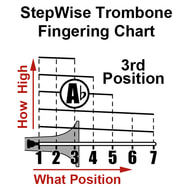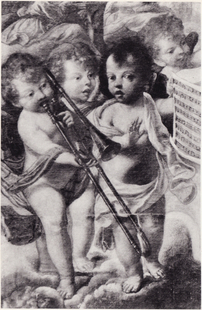How to Play the Trombone - Slide Position Chart & Flashcards
Download the StepWise Trombone Slide Position Chart
|
The fingering chart in the back of the typical band method shows trombone notes one at a time, from lowest to highest, spread across two pages. The StepWise Trombone Slide Position Chart organizes all notes into the overtone series (by partials), according to slide position, making it more effective at helping students make sense of the notes and fingering on the trombone. It shows all the notes on one single-sided page! This allows young trombonists to place the chart on their music stand and use it frequently as they encounter unfamiliar notes.
This free chart makes it much easier for young musicians to memorize the notes AND to play each note on the correct partial. It also gives teachers a powerful tool for physically pointing out exactly where a note should be (how high or low, and in which position) when students are playing it wrong. Using these charts in combination with the StepWise flashcards is one of the great keys to my success as a music teacher! | ||||||
Check out the NinGenius Music App: a super FUN way to learn ALL the notes and fingerings on the trombone! |
Trombone Flashcards: Notes & Fingerings
|
Trombone students tend to learn the notes of their B-Flat Major Scale very well, but struggle with many other notes (such as that horrible E-Natural), including less common accidentals and notes in the upper and lower ranges of the instrument.
These flashcards will help beginning (and more advanced) trombonists to learn, memorize, and master every note, note name, and slide position on the trombone. They can be used in class with a variety of strategies and games (8 are provided), as well as at home. Imagine the possibilities when parents are able to effectively help and coach their young musicians at home! |
|
How the Trombone Works: Slide Positions, Notes, and Partials
|
On StepWise trombone fingering charts the trombone positions are shown across the bottom, and are shown in relation to the bell. Notice that 3rd position is not really AT the bell, but slightly BEFORE it.
It is also important to notice that the distance between each position is slightly longer than the one before it. This is because according to the natural laws of acoustics, half-steps are not linear multiples of the frequencies of neighboring tones. For details on how to find the wavelengths of half-steps and other intervals, click here. The StepWise slide position chart accurately demonstrates the length of each position from the mouthpiece. The most unique thing about this chart is that it shows how high or low to "buzz" your lips in order to hit each note. The horizontal slanted lines are called a "partials", or sometimes an "overtone". To play the A-flat note shown here you must place the slide in 3rd position and then buzz the mouthpiece up to the 3rd Partial. Most fingering charts do not show how high or low a note is, only the slide position. |
|
|
Want to hear what incredible sounds the trombone is capable of making? Check out this YouTube video of the Professors Trombone Choir of the Southeast Trombone Symposium playing themes from the original Superman movie, scored by John Williams. Wow!!
|
History of the TromboneThe trombone has been in use since the early 1400's, and was the first brass instrument that made playing all chromatic tones possible. For a detailed history of the trombone, click here.
It was first associated with religious music, and was commonly played in churches and cathedrals. The trombone began appearing in secular orchestral music at the time of Mozart, and became a standard orchestral instrument at the time of Beethoven. What makes the trombone unique among brass instruments is the hand slide, which is moved continually while playing. Other brass instruments have tuning slides, but they are only moved in or out when adjusting the intonation of the instrument. To see all the parts of a trombone, click here, and to explore the parts in greater detail, see this website. |

